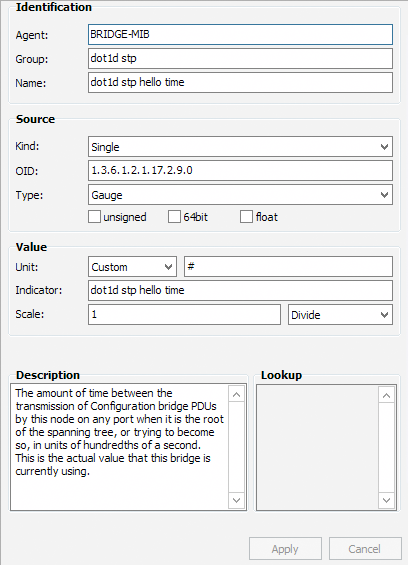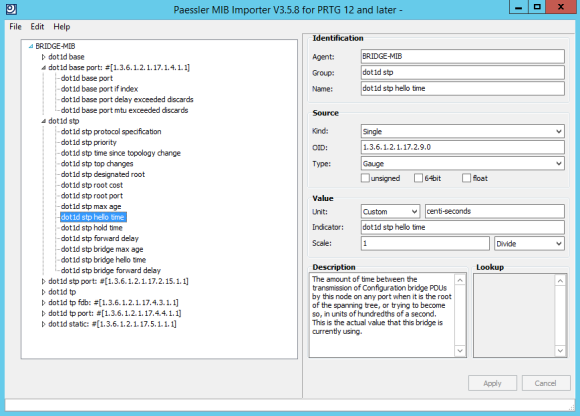SNMP ist eine der am häufigsten verwendeten Technologien im Bereich Netzwerk-Monitoring. Programme zur Bandbreitenüberwachung wie Paessler PRTG nutzen es.
Aber wie funktioniert SNMP?
MIB steht für Management Information Base und ist eine Sammlung von hierarchisch organisierten Informationen. Auf sie wird über ein Protokoll wie SNMP zugegriffen. Es gibt zwei Arten von MIBs: skalare und tabellarische MIBs.
Skalare Objekte definieren eine einzelne Objektinstanz, während tabellarische Objekte mehrere verwandte Objektinstanzen definieren, die in MIB-Tabellen gruppiert sind.
MIBs sind Sammlungen von Definitionen, die die Eigenschaften des verwalteten Objekts innerhalb des zu verwaltenden Geräts festlegen.
MIB-Beispiel: Die typischen Objekte, die bei einem Drucker überwacht werden, sind die verschiedenen Patronenzustände und vielleicht die Anzahl der gedruckten Dateien, und bei einem Switch sind die typischen Objekte von Interesse der eingehende und ausgehende Datenverkehr sowie die Rate der Paketverluste oder die Anzahl der an eine Broadcast-Adresse adressierten Pakete.
OIDs stehen für Object Identifiers. OIDs identifizieren verwaltete Objekte in einer MIB-Hierarchie eindeutig. Diese kann als Baum dargestellt werden, dessen Ebenen von verschiedenen Organisationen zugewiesen werden. Die MIB-Objekt-IDs (OIDs) der obersten Ebene gehören zu verschiedenen Standardorganisationen.
Anbieter definieren private Zweige mit verwalteten Objekten für ihre eigenen Produkte.
Hier ist ein Beispiel für die Struktur einer OID:
oder einfach:
Diese SNMP OID-Nummern werden in PRTG bei der Einrichtung von benutzerdefinierten Sensoren verwendet, um auf die entsprechenden Elemente des zu überwachenden Geräts zuzugreifen. OIDs werden in der Regel von den Hardwareherstellern zur Verfügung gestellt oder sind in so genannten OID-Repositories zu finden, wo auf Sammlungen von MIB-Bäumen und die entsprechenden OIDs zugegriffen werden kann.
PRTG liest diese OIDs aus und ordnet sie dem jeweiligen Gerät zu, bzw. überwacht das ausgewählte Gerät und dessen OID spezifisch. Mehr Informationen über PRTG...

Eigenschaften einer OID

OID Bibliothek im MIB-Importer geöffnet
Benachrichtigungen in Echtzeit bedeuten eine schnellere Fehlerbehebung, so dass Sie handeln können, bevor ernstere Probleme auftreten.
SNMP steht für Simple Network Management Protocol (einfaches Netzwerkverwaltungsprotokoll). Seine Nützlichkeit in der Netzwerkadministration ergibt sich daraus, dass es die standardisierte Erfassung von Informationen über netzwerkgebundene Geräte ermöglicht – und zwar geräteübergreifend über eine Vielzahl von Hardware- und Softwaretypen hinweg.
SNMP ist ein Protokoll zur Übertragung von Verwaltungsinformationen in Netzwerken, insbesondere für den Einsatz in LANs, abhängig von der gewählten SNMP-Version.
SNMP Version 1, der von PRTG unterstützte SNMP-Standard, war die erste Entwicklung des SNMP-Protokolls. Eine Beschreibung ist im Request for Comments (RFC) 1157 zu finden, und es funktioniert innerhalb der Spezifikation der Structure of Management Information (SMI).
Es funktioniert über User Datagram Protocol (UDP), Internet Protocol (IP), OSI Connectionless Network Services (CLNS), AppleTalk Datagram Delivery Prtocol (DDP) und Novell Internet Packet Exchange (IPX). SNMP v1 gilt in der Internet-Gemeinschaft als das De-facto-Netzwerkmanagementprotokoll.
SNMP funktioniert auf der Grundlage, dass Netzwerkverwaltungssysteme eine Anfrage aussenden und die verwalteten Geräte eine Antwort zurücksenden. Dies wird mit einer von vier Operationen realisiert: Get, GetNext, Set und Trap. SNMP-Nachrichten bestehen aus einem Header und einer PDU (Protocol Data Units). Die Header bestehen aus der SNMP-Versionsnummer und dem Community-Namen. Der Community-Name wird bei SNMP als eine Form der Sicherheit verwendet. Die PDU hängt von der Art der Nachricht ab, die gesendet wird. Get, GetNext und Set sowie die Antwort-PDU bestehen aus den Feldern PDU-Typ, Request-ID, Fehlerstatus, Fehlerindex und Objekt/Variable. Der Trap besteht aus den Feldern Enterprise, Agent, Agent address, Generic trap type, Specific trap code, Timestamp und Object/Value.
MIBs sind eine Sammlung von Definitionen, die die Eigenschaften des verwalteten Objekts innerhalb des zu verwaltenden Geräts (z. B. Router, Switch usw.) definieren. Jedes verwaltete Gerät führt eine Datenbank mit Werten für jede der in der MIB enthaltenen Definitionen. Sie ist also nicht wirklich datenbank-, sondern implementierungsabhängig. Jeder Hersteller von SNMP-Geräten hat einen exklusiven Abschnitt der MIB-Baumstruktur unter seiner Kontrolle.
Um dies alles richtig zu organisieren, werden alle verwaltbaren Funktionen aller Produkte (von jedem Hersteller) in diesem Baum angeordnet. Jeder "Zweig" dieses Baums hat eine Nummer und einen Namen, und der vollständige Pfad von der Spitze des Baums bis hinunter zu dem Punkt, der von Interesse ist, bildet den Namen für diesen Punkt. Dies ist die OID. Knoten in der Nähe der Spitze des Baums sind sehr allgemeiner Natur. Um z. B. ins Internet zu gelangen, muss man bis zur vierten Ebene vordringen. Je weiter man sich nach unten bewegt, desto spezifischer werden die Namen, bis man ganz unten ankommt, wo jeder Knoten eine bestimmte Funktion auf einem bestimmten Gerät (oder Agenten) darstellt.
PRTG ist eine umfassende Monitoring-Software für Netzwerke und überwacht Ihre gesamte IT-Infrastruktur.
Diese Windows-basierte Netzwerk-Monitoring-Software und plattformübergreifende ASP-Dienstleistung ermöglicht eine einfache und kostengünstige Früherkennung von Netzwerk- und Website-Ausfällen. So können Ausfallzeiten minimiert und wirtschaftliche Schäden vermieden werden. Das Server-Monitoring unterstützt Unternehmen bei der Überwachung kritischer Netzwerkressourcen und bei der sofortigen Erkennung von Systemausfällen oder Leistungsproblemen.
Kostenlose Freeware verfügbar! Mehr...